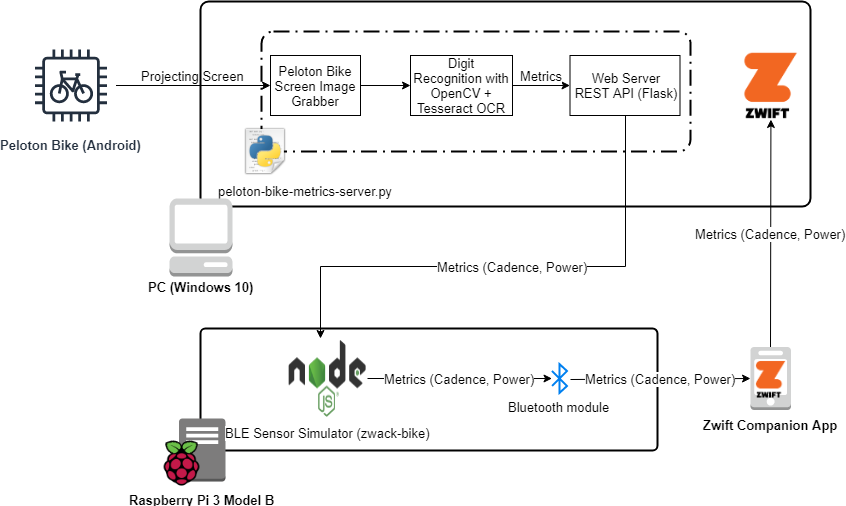Simulate/Implement a Bluetooth Low Energy sensor that can send Cycling Power and Cadence (CSP Bluetooth profile).
Zwack Bike has many possible uses, here are some examples:
- Simulate an indoor bike trainer (turbo) generating cyclist power and cadence data to test bike computers fitness or virtual indoor bike apps.
- Integrate a common treadmill with Zwift, sending data from the treadmill to the Zwift game via Bluetooth
As an example, the code in this project is used to integrate with Peloton Bike Metrics Server to allow Peloton Bike owners to take rides on Zwift.
Diagram of the project:

At this time Zwack runs successfully on Raspberry PI with Bluetooth module (tested on Raspberry Pi 3 Model B).
- Raspberry Pi (theoretically should run in all Bleno (the base BLE module) supported platforms, which are Mac, Windows or Raspberry Pi.)
- Node.js v8.x (The library we use to communicate over Bluetooth doesn't work with the latest versions of Node.js yet.)
Zwack cannot run on the same computer as the fitness or virtual indoor bike app, you'll need to run them on different systems.
Make sure you have Node.js v8.x installed.
On Raspberry Pi it can be installed like this:
curl -sL https://deb.nodesource.com/setup_8.x|sudo -E bash -
sudo apt-get update
sudo apt-get install -y nodejs
sudo apt-get install -y build-essential
Clone this repo and run
npm install
You can see a lot of debug information if you run the simulator or your app with the DEBUG environment variable set to
- csp - Cycling Power and Cadence messages
- ble - Bluetooth low energy messages
Example:
DEBUG=rsc npm run simulator
You'll see something similar to this
rsc [Zwack notifyRSC] {"speed":4.4703888888888885,"cadence":180} +0ms
rsc Running Speed: 4.4703888888888885 +2ms
rsc Running Cadence: 180 +0ms
rsc [Zwack notifyRSC] {"speed":4.4703888888888885,"cadence":180} +1s
rsc Running Speed: 4.4703888888888885 +0ms
This simulator requires a connection to the Metrics server (can be any HTTP endpoint) that returns metrics as a JSON document:
{"cadence": 85, "power": 102}
NOTE: If you wish to use a standalone simulator please have a look at zwack.
Start the simulator by executing:
npm run simulator -- --server=http://<YOUR METRICS SERVER URL>
E.g.:
npm run simulator -- --server=http://192.168.1.213:5000/metrics
On a different machine start your fitness app, bike computer or indoor virtual bike simulation software, like Zwift, and pair up the Zwack BLE sensor. The sensor name should be Zwack, it may have some numbers added to the name or you may see the hostname of the computer running zwack. It all depends on the operating system you're uing to run Zwack.
If your indoor biking software does not detect the BLE sensor, disable, then enable, the Bluetooth on the machine where Zwack is running and retry to discover and connect to the sensor again.
The ZwackBLE sensor may show up as Zwack or has the hostname of the machine running Zwack. This is normal.
Press x or q to exit Zwack.
If you like this project, please consider doing the following:
- Starring on GitHub
- Buying me a coffee
